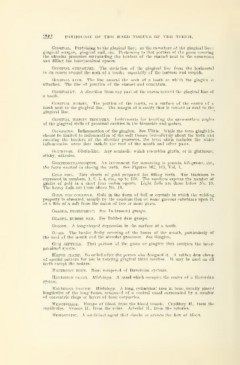Page 550 - My FlipBook
P. 550
292 PATHOLOGY OF THE HARD TISSUES 0¥ THE TEETH.
Gingival. Pertainiug to the gingival line; as the curvature of the gingival line;
gingival margin; gingival wall, etc. Pertaining to that portion of the gums covering
the alveolar processes surrounding the borders of the enamel next to the cementum
and filling the interproximal spaces.
Gingival curvature. The deviation of the gingival line from the horizontal
in its course around the neck of a tooth ; especially of the incisors and cuspids.
Gingival line. The line around the neck of a tooth at which the gingiva is
attached. The line of junction of the enamel and cementum.
Gingivally. a direction from any part of the crown toward the gingival line of
a tooth.
Gingival margin. The portion of the crown, or a surface of the crown of a
tooth next to the gingival line. The margin of a cavity that is toward or next to the
*
gingival line.
Gingival margin trimmers. Instruments for beveling the eavo-surface angles
of the gingival walls of proximal cavities in the bicuspids and molars.
Gingivitis. Inflammation of the gingivje. See Ulitis. While the term gingivitis
should be limited to inflammation of the soft tissues immediately about the teeth and
covering the borders of the alveolar processes, the term ulitis includes the wider
inflammation areas that include the roof of the mouth and other parts.
Glutinoid. Glutin-like. Any semisolid which resembles glutin, or is glutinous;
sticky, adhesive.
Gnathodynamometer. An instrument for measuring in pounds, kilograms, etc.,
the force exerted in closing the teeth. See Figures 162, 163, Vol. 1.
Gold foil. Thin sheets of gold prepared for filling teeth. The thickness is
expressed in numbers, 1, 2, 3, 4, etc., up to 120. The numbers express the number of
grains of gold in a sheet four inches square. Light foils are those below No. 10.
The heavy foils are those above No. 10.
Gold, non-cohesive. Gold in the form of foil or crystals in which the welding
property is obscured, usually by the condensation of some gaseous substance upon it,
or a film of a salt from the union of two or more gases.
Grasps, instrument. See Instrument grasps.
Grasps, rubber dam. See Rubber dam grasps.
Groove. A long-shaped depression in the surface of a tooth.
Gums. The harder fleshy covering of the bones of the mouth, particularly of
the roof of the mouth and the alveolar processes. See Gingiva.
Gum septums. That portion of the giuns or gingiva that occupies the inter-
proximal spaces.
H.\.tch clamp. So called after the person who designed it. A rubber dam clamp
of special pattern for use in treating gingival third cavities. It may be used on all
teeth except the molars.
Haversian bone. Bone composed of Haversian .systems.
Haversian canal. Eistolof/y. A canal which occupies the center of a Haversian
system.
Haversian system. Histolor/it. A long, cylindrical area in bone, usually placed
lengthwise of the long bones, composed of a central canal surrounded by a number
of concentric rings or layers of bone corpuscles.
Hemorrhage. Escape of blood from the blood vessels. Capillary H., from the
capillaries. Venous H., from the veins. Arterial H., from the arteries.
Hemostatic. A medicinal agent that checks or arrests the flow of blood.


